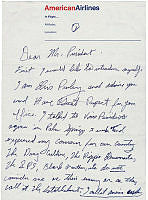The Working White House: Learning the Ropes
Copyright © White House Historical Association. All rights reserved under international copyright conventions. No part of this article may be reproduced or utilized in any form or by any means, electronic or mechanical, including photocopying, recording, or by any information storage and retrieval system, without permission in writing from the publisher. Requests for reprint permissions should be addressed to books@whha.org
Gallery
-

Valentino Melah immigrated to America as a child in 1834 and became a shoe salesman and innkeeper. In 1869, President Ulysses S. Grant hired him to serve as White House steward. He may have been the first White House worker to come from a hotel background, but he was certainly not the last. In an 1871 article, Frank Leslie’s Illustrated Newspaper referred to Melah as “Professor,” observing that he had “graduated” from some of the East Coast’s leading hotels. The man standing, left, with beard and moustache, is believed to be Melah.
White House Collection/White House Historical Association -

Preparing desserts at a state dinner, 1965. Behind the scenes at a state dinner in honor of Ludwig Erhard, Chancellor of West Germany, White House workers prepare the desserts and liqueurs. Butler Norwood Williams observed, “Everyone works like a team. You have a crew that comes in and moves furniture and sets up tables; you have the cleaning staff, the storeroom person, the chefs, the flower shop; even the carpenter’s shop—they had to make some of those tables. You know how everyone pitches in at a circus? That’s the way it’s done!”
White House Historical Association -

Rockwood Peyton vacuuming the Blue Room, 1983. After vacuuming, Rockwood Peyton might have used a small push broom to brush the wool nap in the same direction. During the Eisenhower administration, the White House residence staff carefully walked around the carpets, so as not to disturb the brush finish.
Ronald Reagan Presidential Library and Museum/NARA -

Sam Whiting checking Christmas lights, 1991. The holiday season is an especially busy time at the White House. Some electricians work 16 or 17 hours a day in order to light all the trees inside the mansion. The official Christmas tree in the Blue Room usually has 10,000 to 13,000 lights.
George Bush Presidential Library and Museum/NARA -

Chocolate mold, 1990s. “I had to produce glossy, smooth confections on an almost daily basis at the White House,” recalled former executive pastry chef Roland Mesnier. Rather than selecting a metal mold for making individual candies, Mesnier preferred a plastic form such as this one, designed to yield nine candies, each embossed with the presidential seal.
Lent by The White House -

Handbooks such as these would have provided guidelines for service and etiquette. One of the authors, Robert Roberts, an African American, served as butler and majordomo in the household of Massachusetts Senator and Governor Christopher Gore. Tunis G. Campbell, an African American preacher and abolitionist, worked as a hotel steward in New York and Boston.
Left: Pullman's Palace Car Company Car-Service Rules, 1893. Newberry Library. Right: Lewis Hotel Training Course by Clifford Lewis, 1941. Lewis Hotel Training School. -

Book cover: Hotel Keepers, Head Waiters, and Housekeepers’ Guide by Tunis G. Campbell, 1848
Coolidge and Wiley -

Book cover: The House Servant’s Directory, or A Monitor for Private Families: Comprising Hints on the Arrangement and Performance of Servants’ Work by Robert Roberts, 1827
Munroe & Francis
I thought I knew how to serve. But the White House is different. Other places you can make mistakes and you don’t feel so bad; but you don’t feel like making mistakes for the president and first lady.
White House workers have frequently come to their jobs with experience in hotels and resorts, in large town or country houses, or in the railroad industry as conductors and porters. In these settings, workers developed the poise, polish, and professionalism needed to attend to the most discerning patrons.
Their prior training served these individuals well in the White House, but each employee quickly had to learn the ways of the Executive Mansion: what to do and when to do it, who was in charge, how to offset a crisis, and how to adjust to the first family’s tastes and preferences. Some new workers were assigned mentors; others were on their own to discover what was expected of them at America’s most recognized address.
White House workers share a cooperative spirit that in turn helps to foster strong bonds among the staff. Employees from many different units collaborate regularly to help each other prepare for special events or accomplish daily tasks.
























































